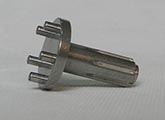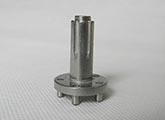The Metal Sintering Process
The powder metallurgy process is the blending of fine powdered materials (in this case powdered metals) and pressing these powders into a desired shape. After the desired shape has been achieved, the compressed part is heated in a controlled atmosphere, causing the material to bond.
 |
 |
 |
ChinaSavvy’s metal sintering process, also commonly known as the powder metallurgy process, is divided into three main steps:
Note: Also see Secondary Operations
Blending
The process starts with the blending of powdered metals. In metal sintering, an iron based powder mix is the initial material. Based on the properties required, alloying elements and additives are added to the mix.
Powder mixes also contain a solid lubricant. This lubricant is needed in order to reduce the friction between the powder mass and the surface of the tool used for compaction.
Blending in the powder metallurgy process enables the creation of an uniform mixture, provides the required material properties and ensures that a minimum amount of friction occurs in the compaction stage.
Compaction
Normally, carbide and steel tools are used in the compaction step of the process, with the load being applied axially. The amount of powder needed is predetermined and then delivered under gravity to the tool.
A filling shoe is used to deliver the powder metal to the cavity of the die and then compacted with a force of between 400 MPa to 800MPa. After the initial compaction, the ‘green’ part formed has a density of around 85% to 95%.
This process allows for the pressing of complex parts in a single operation while maintaining a relatively high production rate – usually up to 25 parts per minute.
After being compacted, the part to be produced has its desired shape, but not yet its final dimensions. For this reason, allowances are made for shrinkage that occurs during the sintering step of the process.
Note that the compaction of powder is cable of permitting a wide range of radial aspects and design flexibility.
Sintering
In order for the ‘green’ part formed in the compaction step of the process to meet the required mechanical properties, parts must be sintered.
A heat treatment process, sintering is usually performed on a belt conveyor furnace in a controlled atmosphere.
Parts are now heated in the furnace to a temperature that is below the melting point of the main powdered metals used in the blending step of the process. Times for heating varies depending on the final part application, materials used and physical requirements.
During the sintering process, the powder grains of the ‘green’ part grow together through a diffusion process and bonds, resulting in an improvement in the part’s mechanical properties.
During sintering, minor shrinkage takes place (for which allowances has been taken in the compaction step), giving the part its final required dimensions. Note that the properties of the part can be adjusted by adjusting the rate at which the part is left to cool.
The Furnace
Thee are three furnace zones, known as:
-
Pre-heating:
Here, the lubricant melts, exudes to the surface or vaporizes. Note that an in-adequate de-lubrication can lead to blistering and sooting of parts in the Sintering or Hot Zone. -
Sintering:
Also known as the Hot Zone. Here, oxides in the controlled atmosphere is reduced and the diffusion process takes place in which the powder particles bond. -
Cooling:
The part undergoes cooling processes in which the ingress of air and the oxidation of parts are prevented.
Controlled atmospheres used in the furnace for sintering:
- A nitrogen – hydrogen atmosphere
- A hydrogen atmosphere
- Vacuum
- Dissociated Ammonia
- An Endothermic gas atmosphere
Also explore other types of sintering processes including Selective Laser Sintering (SLS), Direct Metal Laser Sintering (DMLS), Liquid Phase Sintering, Electric Current Assisted Sintering and Pressureless Sintering.
Secondary Operations
Noted here are common secondary operations used on sintered metal parts:
- Coining and Resizing
- Steam Treatment
- Heat Treatment
- Vacuum or Oil Impregnation
- Structural Infiltration
- Resin or Plastic Impregnation
- Machining
- Grinding
- Surface Finishing
Coining and Resizing
While most parts are nearly finished after the sintering process step, some parts do require sizing or coining operations in order to improve its structural and dimensional aspects. Sizing is able to decrease dimensional variations while coining can increase the part’s density and thus its strength. Note that some materials might need to be re-sintered after coining processes in order to re-fuse particles.
Also, coining does not occur at a fast rate, negatively impacting the cost per part.
Steam Treatment
This process is capable of increasing the sintered metal part’s resistance to corrosion, surface hardness, resistance to wear, reduces porosity, improves material density and improves the part’s surface for plating processes.
Heat Treatment
Sintered metal parts are heat treated in order to to increase the material hardness and strength, as well as increase the material’s resistance to wear.
Vacuum or Oil Impregnation
This operation makes sintered metal bearing self lubricating.
Structural Infiltration
This operation is capable of improving strength, reducing porosity and improves both ductility and machinability. Structural infiltration also seals parts so that parts are liquid and gas tight and is used to prepare the part surface for plating with other metals.
Resin or Plastic Impregnation
This operation can be used in order to improve machinability, prepare the surface of the part for plating processes and to seal the part, making it liquid or gas tight.
Machining
Machining processes here include threading, boring, milling, drilling, turning, tapping and broaching.
Grinding
Grinding on sintered metal parts includes homing, lapping and polishing.
Surface Finishing
Done in order to improve the part’s surface finish, processes here includes plating, tumbling, coating, deburring and vibratory processes.
You can also learn more about the advantages and disadvantages of the metal sintering process.
Back to Main Page: Sintered Metal Manufacturers
Further Suggested Reading:
- Metal Sintering versus Metal Injection Molding
- Shapes that can be Sintered
- Materials used in Metal Sintering
- The Alternative Metal Sintering Process
